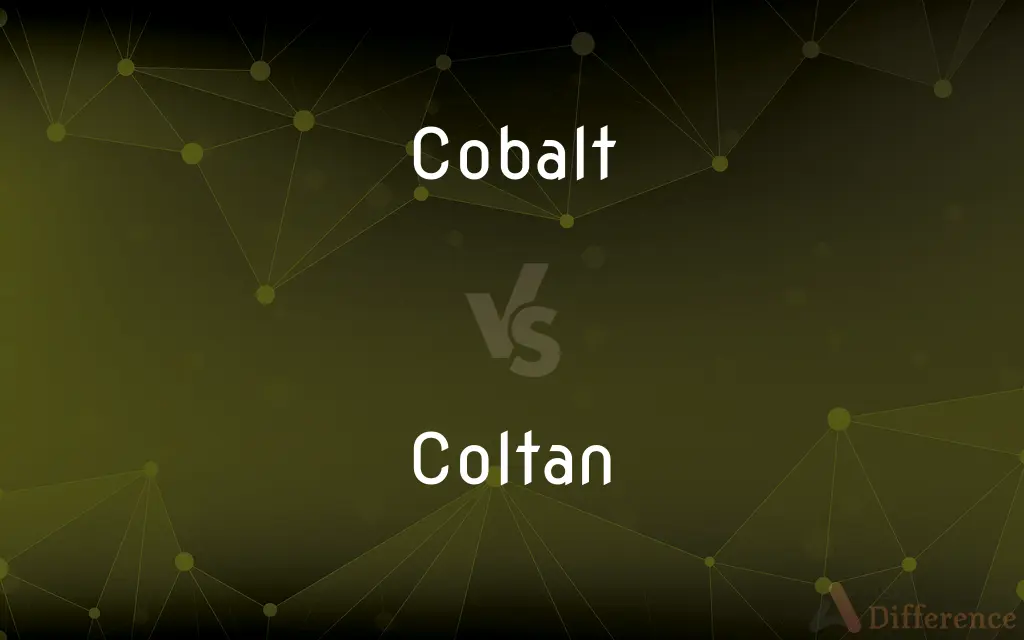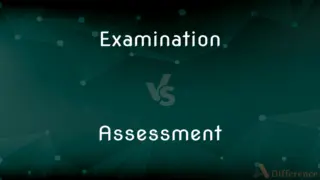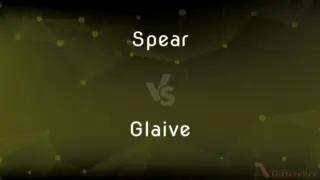Cobalt vs. Coltan — What's the Difference?
By Fiza Rafique — Updated on November 3, 2023
Cobalt is a metallic element, while coltan is a mineral ore containing niobium and tantalum.

Difference Between Cobalt and Coltan
Table of Contents
ADVERTISEMENT
Key Differences
Cobalt is a chemical element with the symbol Co and atomic number 27. It is a hard, lustrous, silver-gray metal that is used in the production of high-strength alloys, magnets, and rechargeable batteries. Cobalt is also important in the medical field for radiotherapy. Coltan, on the other hand, is a colloquial name for columbite-tantalite, a mineral from which niobium and tantalum are extracted. Tantalum from coltan is used in electronic components, such as capacitors and high-end audio systems, due to its ability to store and release electrical energy.
Cobalt has significant strategic and economic value due to its use in modern technologies like electric vehicles and renewable energy systems. Its extraction is often linked to the Democratic Republic of Congo, where mining conditions have raised ethical concerns. Coltan's importance comes primarily from tantalum's role in electronics manufacturing. The mining of coltan has also faced scrutiny for environmental and ethical reasons, particularly in African countries where the mineral is abundant.
While cobalt is a pure element, coltan is a composite mineral. Alloys containing cobalt have high-temperature stability and corrosion resistance, which are valuable in jet turbines and gas turbine generators. Coltan-derived tantalum is valued for its thermal stability and resistance to corrosion, which is essential in mobile phones, DVD players, video game systems, and computers.
The global demand for cobalt is on the rise, particularly for its role in lithium-ion batteries, which power a wide range of electronic devices and electric cars. Similarly, as the demand for electronic devices grows, so does the demand for coltan, due to tantalum's critical role in electronics. Both minerals are considered conflict resources, as their mining has been linked to human rights abuses and conflicts, particularly in the central African region.
Cobalt blue is a famous pigment used in glassware and ceramics, a testament to its historical significance in art and decoration. While coltan does not share this aesthetic application, its byproducts are embedded in the fabric of modern technology, invisibly present in the gadgets that are now a ubiquitous part of daily life.
ADVERTISEMENT
Comparison Chart
Classification
Chemical element with symbol Co.
Mineral ore containing niobium and tantalum.
Primary Use
Alloys, batteries, and pigments.
Source of tantalum for electronic components.
Industrial Significance
Essential for aerospace and electric vehicles.
Crucial for consumer electronics and capacitors.
Environmental and Ethical Concerns
Mining often linked to ethical concerns.
Mining associated with environmental and social issues.
Physical State
Metallic element.
Composite mineral ore.
Compare with Definitions
Cobalt
A contributor to color.
Cobalt adds a rich blue hue to glass.
Coltan
A tantalum-bearing ore.
Coltan extraction is controversial due to its environmental impact.
Cobalt
A magnetic material.
Cobalt's magnetic properties are valuable in making powerful magnets.
Coltan
A conflict resource.
The trade of coltan has fueled conflict in certain regions of Africa.
Cobalt
A metal used in alloys.
The jet engine's durability is due to a cobalt-based alloy.
Coltan
A mineral blend.
Coltan combines columbite and tantalite in its composition.
Cobalt
A medical isotope.
Cobalt-60 is a radioactive isotope used in cancer treatment.
Coltan
A heat-resistant material.
Coltan's derivatives are used in high-temperature alloy applications.
Cobalt
A chemical element.
Cobalt is used to manufacture electric car batteries.
Coltan
An electronic component precursor.
Smartphones rely on tantalum from coltan for their capacitors.
Cobalt
Cobalt is a chemical element with the symbol Co and atomic number 27. Like nickel, cobalt is found in the Earth's crust only in a chemically combined form, save for small deposits found in alloys of natural meteoric iron.
Coltan
Coltan (short for columbite–tantalites and known industrially as tantalite) is a dull black metallic ore from which the elements niobium and tantalum are extracted. The niobium-dominant mineral in coltan is columbite (after niobium's original American name columbium), and the tantalum-dominant mineral is the tantalite.Tantalum from coltan is used to manufacture tantalum capacitors which are used for mobile phones, personal computers, automotive electronics, and cameras.
Cobalt
A hard, brittle metallic element, found associated with nickel, silver, lead, copper, and iron ores and resembling nickel and iron in appearance. It is used chiefly for magnetic alloys, high-temperature alloys, and in the form of its salts for blue glass and ceramic pigments. Atomic number 27; atomic weight 58.9332; melting point 1,495°C; boiling point 2,927°C; specific gravity 8.9; valence 2, 3. See Periodic Table.
Coltan
See columbite-tantalite.
Cobalt
A chemical element (symbol Co) with an atomic number of 27: a hard, lustrous, silver-gray metal.
Coltan
(mineralogy) A metallic ore, (Fe,Mn)(Ta,Nb)2O6, from which the elements niobium and tantalum are extracted.
Coltan is used for the production of tantalum capacitors.
Cobalt
Cobalt blue.
Coltan
A valuable black mineral combining niobite and tantalite; used in cell phones and computer chips
Cobalt
A tough, lustrous, reddish white metal of the iron group, not easily fusible, and somewhat magnetic. Atomic weight 59.1. Symbol Co.
Cobalt
A commercial name of a crude arsenic used as fly poison.
Cobalt
A hard ferromagnetic silver-white bivalent or trivalent metallic element; a trace element in plant and animal nutrition
Common Curiosities
What does coltan contain?
Coltan contains niobium and tantalum, used primarily in electronic components.
Where is cobalt found?
Cobalt is primarily mined in the Democratic Republic of Congo but found globally.
Why is coltan important?
Coltan is important for producing tantalum, which is used in many electronic devices for its ability to store and release electricity.
What are "cobalt blue" products?
"Cobalt blue" products are items colored with a blue pigment derived from cobalt.
Can cobalt be recycled?
Yes, cobalt can be recycled, particularly from used batteries.
Is cobalt mining harmful?
Cobalt mining can be environmentally challenging and has been linked to human rights abuses.
What is cobalt used for?
Cobalt is used in rechargeable batteries, alloys, pigments, and as a radioisotope in medicine.
What are the alternatives to cobalt?
Alternatives to cobalt in batteries include nickel and manganese chemistries.
Is coltan a metal?
No, coltan is not a metal; it's an ore from which metals like niobium and tantalum are extracted.
How is coltan mined?
Coltan is mined using both industrial mining and artisanal mining practices, sometimes involving manual labor.
Is there a synthetic substitute for cobalt?
While there are no complete synthetic substitutes for cobalt, research is ongoing to reduce its use in batteries and other technologies.
Are coltan mines sustainable?
Sustainability in coltan mines is an issue due to environmental damage and conflict financing concerns.
How does cobalt affect the economy?
Cobalt is economically significant due to its use in growing industries like electric vehicles.
Can coltan be found outside Africa?
Yes, coltan can be found in other parts of the world, including Australia and South America.
What electronics use coltan?
Coltan is used in almost all electronic devices, including phones, laptops, and cameras.
Share Your Discovery

Previous Comparison
Examination vs. Assessment
Next Comparison
Spear vs. GlaiveAuthor Spotlight
Written by
Fiza RafiqueFiza Rafique is a skilled content writer at AskDifference.com, where she meticulously refines and enhances written pieces. Drawing from her vast editorial expertise, Fiza ensures clarity, accuracy, and precision in every article. Passionate about language, she continually seeks to elevate the quality of content for readers worldwide.
















































